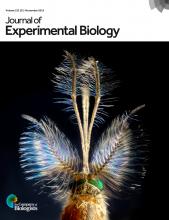Ver ítem
- xmlui.general.dspace_homeCentros Regionales y EEAsCentro Regional Patagonia NorteEEA BarilocheArtículos científicosxmlui.ArtifactBrowser.ItemViewer.trail
- Inicio
- Centros Regionales y EEAs
- Centro Regional Patagonia Norte
- EEA Bariloche
- Artículos científicos
- Ver ítem
Honeybees generalize among pollen scents from plants flowering in the same seasonal period
Resumen
When honey bees (Apis mellifera) feed on flowers, they extend their proboscis to absorb the nectar, i.e. they perform the proboscis extension response (PER). The presence of pollen and/or nectar can be associated with odors, colors or visual patterns, which allows honey bees to recognize food sources in the environment. Honey bees can associate similar, though different, stimuli with the presence of food; i.e. honey bees discriminate and generalize among
[ver mas...]
When honey bees (Apis mellifera) feed on flowers, they extend their proboscis to absorb the nectar, i.e. they perform the proboscis extension response (PER). The presence of pollen and/or nectar can be associated with odors, colors or visual patterns, which allows honey bees to recognize food sources in the environment. Honey bees can associate similar, though different, stimuli with the presence of food; i.e. honey bees discriminate and generalize among stimuli. Here, we evaluated generalization among pollen scents from six different plant species. Experiments were based on the PER conditioning protocol over two phases: (1) conditioning, in which
honey bees associated the scent of each pollen type with sucrose, and (2) test, in which honey bees were presented with a novel scent, to evaluate generalization. Generalization was evinced by honey bees extending their proboscis to a novel scent. The level of PER increased over the course of the conditioning phase for all pollen scents. Honey bees generalized pollen from Pyracantha coccinea
and from Hypochaeris radicata. These two plants have different amounts of protein and are not taxonomically related. We observed that the flowering period influences the olfactory perceptual similarity and we suggest that both pollen types may share volatile compounds that play key roles in perception. Our results highlight the importance of analyzing the implications of the generalization between pollen types of different nutritional quality. Such studies could provide valuable information for beekeepers and agricultural producers, as the generalization of a higher quality pollen can benefit hive development, and increase pollination and honey production.
[Cerrar]

Autor
Pietrantuono, Ana Laura;
Requier, Fabrice;
Fernandez Arhex, Valeria Cristina;
Winter, Josefina;
Huerta, Guillermo Jose;
Guerrieri, Fernando;
Fuente
Journal of Experimental Biology 222 (November 2019)
Fecha
2019-11
Editorial
The Company of Biologists
ISSN
0022-0949
1477-9145
1477-9145
Formato
pdf
Tipo de documento
artículo
Palabras Claves
Derechos de acceso
Restringido
 Excepto donde se diga explicitamente, este item se publica bajo la siguiente descripción: Creative Commons Attribution-NonCommercial-ShareAlike 2.5 Unported (CC BY-NC-SA 2.5)
Excepto donde se diga explicitamente, este item se publica bajo la siguiente descripción: Creative Commons Attribution-NonCommercial-ShareAlike 2.5 Unported (CC BY-NC-SA 2.5)

